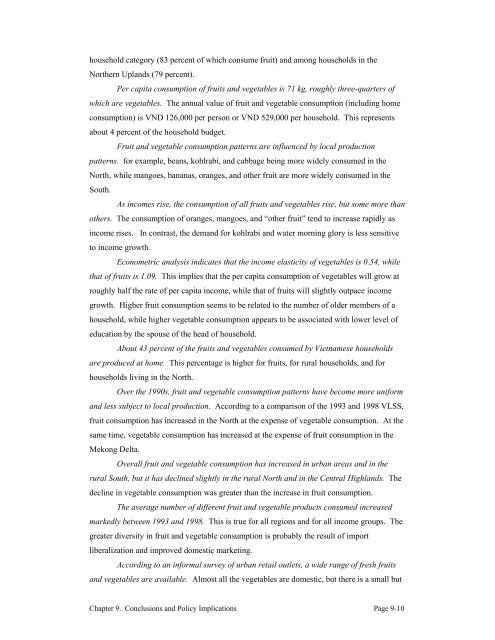Fruits and Vegetables in Vietnam - International Food Policy ...
Fruits and Vegetables in Vietnam - International Food Policy ...
Fruits and Vegetables in Vietnam - International Food Policy ...
Create successful ePaper yourself
Turn your PDF publications into a flip-book with our unique Google optimized e-Paper software.
household category (83 percent of which consume fruit) <strong>and</strong> among households <strong>in</strong> the<br />
Northern Upl<strong>and</strong>s (79 percent).<br />
Per capita consumption of fruits <strong>and</strong> vegetables is 71 kg, roughly three-quarters of<br />
which are vegetables. The annual value of fruit <strong>and</strong> vegetable consumption (<strong>in</strong>clud<strong>in</strong>g home<br />
consumption) is VND 126,000 per person or VND 529,000 per household. This represents<br />
about 4 percent of the household budget.<br />
Fruit <strong>and</strong> vegetable consumption patterns are <strong>in</strong>fluenced by local production<br />
patterns. for example, beans, kohlrabi, <strong>and</strong> cabbage be<strong>in</strong>g more widely consumed <strong>in</strong> the<br />
North, while mangoes, bananas, oranges, <strong>and</strong> other fruit are more widely consumed <strong>in</strong> the<br />
South.<br />
As <strong>in</strong>comes rise, the consumption of all fruits <strong>and</strong> vegetables rise, but some more than<br />
others. The consumption of oranges, mangoes, <strong>and</strong> “other fruit” tend to <strong>in</strong>crease rapidly as<br />
<strong>in</strong>come rises. In contrast, the dem<strong>and</strong> for kohlrabi <strong>and</strong> water morn<strong>in</strong>g glory is less sensitive<br />
to <strong>in</strong>come growth.<br />
Econometric analysis <strong>in</strong>dicates that the <strong>in</strong>come elasticity of vegetables is 0.54, while<br />
that of fruits is 1.09. This implies that the per capita consumption of vegetables will grow at<br />
roughly half the rate of per capita <strong>in</strong>come, while that of fruits will slightly outpace <strong>in</strong>come<br />
growth. Higher fruit consumption seems to be related to the number of older members of a<br />
household, while higher vegetable consumption appears to be associated with lower level of<br />
education by the spouse of the head of household.<br />
About 43 percent of the fruits <strong>and</strong> vegetables consumed by <strong>Vietnam</strong>ese households<br />
are produced at home. This percentage is higher for fruits, for rural households, <strong>and</strong> for<br />
households liv<strong>in</strong>g <strong>in</strong> the North.<br />
Over the 1990s, fruit <strong>and</strong> vegetable consumption patterns have become more uniform<br />
<strong>and</strong> less subject to local production. Accord<strong>in</strong>g to a comparison of the 1993 <strong>and</strong> 1998 VLSS,<br />
fruit consumption has <strong>in</strong>creased <strong>in</strong> the North at the expense of vegetable consumption. At the<br />
same time, vegetable consumption has <strong>in</strong>creased at the expense of fruit consumption <strong>in</strong> the<br />
Mekong Delta.<br />
Overall fruit <strong>and</strong> vegetable consumption has <strong>in</strong>creased <strong>in</strong> urban areas <strong>and</strong> <strong>in</strong> the<br />
rural South, but it has decl<strong>in</strong>ed slightly <strong>in</strong> the rural North <strong>and</strong> <strong>in</strong> the Central Highl<strong>and</strong>s. The<br />
decl<strong>in</strong>e <strong>in</strong> vegetable consumption was greater than the <strong>in</strong>crease <strong>in</strong> fruit consumption.<br />
The average number of different fruit <strong>and</strong> vegetable products consumed <strong>in</strong>creased<br />
markedly between 1993 <strong>and</strong> 1998. This is true for all regions <strong>and</strong> for all <strong>in</strong>come groups. The<br />
greater diversity <strong>in</strong> fruit <strong>and</strong> vegetable consumption is probably the result of import<br />
liberalization <strong>and</strong> improved domestic market<strong>in</strong>g.<br />
Accord<strong>in</strong>g to an <strong>in</strong>formal survey of urban retail outlets, a wide range of fresh fruits<br />
<strong>and</strong> vegetables are available. Almost all the vegetables are domestic, but there is a small but<br />
Chapter 9. Conclusions <strong>and</strong> <strong>Policy</strong> Implications Page 9-10
















